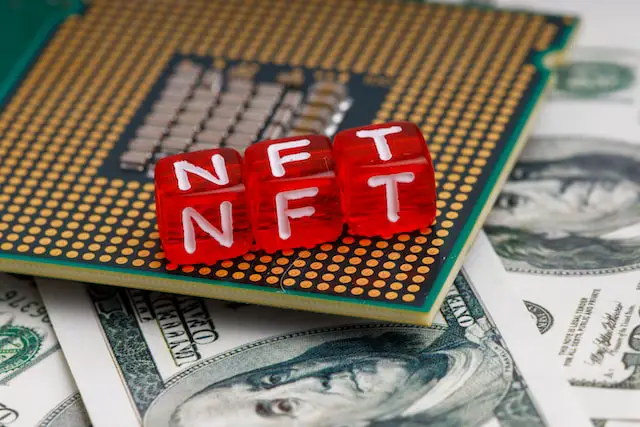If you’ve been going down the crypto rabbit hole, you’ve probably come across NFTs. NFTs are continuing to grow in popularity and some have sold for millions.
But if you’re interested in investing in NFTs, you’ve likely come across numerous NFT terms and you’re feeling perplexed.
This detailed guide will show you some of the most important words from the NFT glossary and how this asset class works. It’ll help you with your investing journey.
Here’s our guide to NFTs for beginners.
What Are NFTs?
NFT stands for Non-Fungible Token. It serves as a proof of ownership for a digital asset. These assets can be any form of media, though at present, digital art has become the most popular asset.
You can read this article to learn more about what NFTs are and how they work. We’ll go into more detail later after we explore some of the popular NFT terms.
The Basic NFT Terms to Know
As NFTs become more popular, one can expect more terms to get added to the NFT glossary.
One is Ether, which refers to the cryptocurrency issued by the Ethereum foundation. As of this initial publication, Ether is the only cryptocurrency that can be used to purchase NFTs.
You can buy NFTs on a platform such as OpenSea, among others. When you make purchases, you’ll have to pay gas fees. Gas refers to a small transaction fee paid via the Ethereum blockchain to purchase the cryptocurrency.
If you invest in NFTs, you might be interested in staking. Staking refers to holding onto an NFT to sell it at a later stage. However, rather than selling it immediately, you’ll sell it many months or even years later.
The final basic NFT term that you should know about is rug pull. It’s the same term that you’ve heard in other contexts.
It refers to scams and there are plenty in the NFT world! Make sure you do your research on any NFT before you buy.
Always speak to your financial advisor and depend on your research rather than on someone else’s opinion.
Now that you know the basic NFT terms, let’s explore how they work and their role and reception among crypto enthusiasts.
How NFTs Work
It’s important to note that the NFT is simply proof of ownership rather than an asset. Often, in everyday lingo, it’s the specific asset that gets referred to as the NFT.
For example, if you own the NFT of a JPEG image, it means that you are the owner of the original version. It doesn’t mean that you have exclusive rights over the asset. Keep this in mind before you decide whether you should invest in NFTs.
Nevertheless, many investors have spent great fortunes on NFTs. Perhaps the most notable example is when Metakovan bought Beeple’s “Everydays” for the equivalent of $69 million.
When you sell an NFT, you are selling the ownership of the asset to another person. The transaction gets made via Ether and you can convert your Ether to other digital assets if needed.
Now let’s look at the more detailed NFT terms that you’ll need to know if you decide to invest.
Airdrop
This shouldn’t be confused with Apple’s Airdrop feature, though it has similar features.
It helps you share NFTs with others for free. This is a great option to send someone an NFT rather than selling it to them and charging Ether for it.
However, you should be a bit careful about receiving NFTs via Airdrop. Often, this is one of the easiest ways to receive scams. Make sure you do your research and never accept an Airdrop from a stranger.
Blue Chip
This is a type of investment that generally has a favorable view by major investors. If an NFT is considered Blue Chip, it means that it has a greater reputation.
For example, the Bored Ape Yacht Club is an example of a Blue Chip. These NFTs are one of the most popular types of NFTs and many top investors are eager to invest in them.
Crypto Wallet
This is where you’ll store the cryptocurrencies of your choice and conduct transactions with them.
You’ll share the public key to send and receive Ether in order to buy and sell NFTs. You can store your crypto wallet on a number of platforms.
One is a web-based wallet. This is where you can use a service such as Coinbase to manage your cryptocurrencies. These are the easiest to use but don’t always give you full control.
Hardware wallets offer more freedom on how you can use your cryptocurrencies. They do, however, require more technical expertise. If you lose your hardware wallet, you won’t be able to recover your crypto at all.
Make sure you experiment with different types of crypto wallets until you find the ideal option for your needs.
DAO
DAO is short for Decentralized Autonomous Organization. This is a group that can get made on the blockchain. It can be voted on by stakeholders who manage the decisions.
These DAOs can also be used to manage and distribute NFTs.
Flip
This refers to the practice of buying an NFT and selling it shortly afterward. This is a great option if you want to make fast cash. It’s also ideal if you feel the price of an NFT might go down in the future.
You’ll want to sell it as fast as possible if you believe this to be true. Flipping is likely to become more popular as NFT investing becomes more prevalent.
Floor Price
This refers to the lowest price that an NFT or collection of NFTs will be. Often, the price is an indication of how valuable these NFTs will be in the long run.
If the price is low, it’s likely to stay low. Don’t fall for buying the cheapest NFT in the hopes that the price will skyrocket in the future. While there’s always a possibility, in most cases it won’t happen at all!
FUD
This is short for “fear, uncertainty, doubt.” This is often an indication that other investors aren’t sure about an NFT project.
If you have an interest in an NFT project, you can share it with other investors. If they respond with ‘FUD’ then you might want to think twice about investing in it.
Metaverse
This is a virtual world where you can interact with others. Among the many things that you can do is view NFTs.
One of the reasons why NFTs became popular is because they can get shared via the Metaverse. If you feel that spending time on Metaverse is worth your while, you might want to consider investing in NFTs.
Minting
This refers to the process of creating an NFT. After the NFT gets created, you’ll share it on the blockchain.
This is a rather complex process and you’ll have to use a service such as OpenSea to create them. You’ll upload your digital asset to the platform first. Afterward, the platform will “mint” the asset into an NFT.
This is crucial if you want to earn Ether from selling your original NFTs. One can expect that NFT will continue to become more popular just as Bitcoin mining has.
Polygon
This is a different type of blockchain that can also handle Ether transactions. It doesn’t charge gas fees as the traditional Ethereum blockchain does.
It’s not as fast as the original blockchain but the savings on transaction fees are often ideal. You might want to consider Polygon first before using the traditional Ethereum blockchain.
Pump and Dump
This is an unethical method of trying to raise the value of an NFT. The goal is to then sell the NFT to make a fast profit.
One shouldn’t engage in pump and dump schemes. As NFTs and cryptocurrency become more popular, one can expect there might be laws against such schemes.
Smart Contract
A smart contract is a code that’s typically used to ensure the functionality and usefulness of the NFT.
This eliminates the requirement to trust the NFT project’s creator. You’ll be able to verify the code yourself and trust it to perform as intended.
Utility
The utility of an NFT encompasses the advantages, offerings, amenities, privileges, or entitlements that you get when you own it.
For example, some NFTs might offer discounts on particular products. Others will often have exclusive entry into a restricted NFT fund. Other NFTs will offer admittance to an online course, admission to exclusive events, or ownership of copyright to a brand.
Should You Invest in NFTs?
Now you know the basic and major NFT terms. Let’s look at whether you want to invest in NFTs and what your approach should be.
One thing you must remember is that the cryptocurrency market is volatile. While fortunes have been made from NFTs, there are other people who have lost lots of money.
You can buy an NFT for a high price today and it might fall later. While NFTs are becoming more popular, there are many others who feel they have no value.
While Ether is the second most popular cryptocurrency, many see it as a useless currency altogether. As Bitcoin maximalism becomes more popular, Ether might lose value.
As mentioned earlier, right now Ether is the only cryptocurrency that works with NFT transactions. The cryptocurrency is completely controlled by the Ethereum Foundation. This means that your currency gets controlled by the foundation.
You might receive your payment in Ether but then your cryptocurrency can freeze. You might want to convert your Ether to another currency, but this transaction can get blocked.
Make sure you think carefully before you invest in NFTs. Nevertheless, NFTs continue to be popular and there is no indication that investors are turning away any time soon.
Best Practices
Let’s end by looking at a few best practices to consider when investing in and transacting with NFTs.
Let’s suppose you’re an artist and you want to mint NFTs. One advantage of selling your art as NFTs is continuous royalties.
For example, let’s say you sell your NFT. You’ll immediately receive Ether from this transaction. If the recipient then sells the NFT to someone else, you’ll receive a commission on this transaction. The chain continues and you’ll always receive a commission.
However, due to the ease of duplicating digital assets, there’s always a fear that you won’t be able to sell NFTs. Someone else might just duplicate your JPEG rather than buy the NFT.
If you want to sell NFTs, you have to keep an eye on the trends. For example, the Bored Ape Yacht Club NFT collection has been popular for a long time.
However, it’s possible that investors will get bored with this collection soon. You might want to invest in a different collection to earn a great profit.
You also want to consider the longevity of NFT’s popularity. While it’s unlikely to go away, you’ll have to consider how popular it will continue to be. NFTs present many exciting opportunities but it’s crucial to always approach investments with a skeptical eye.
As mentioned earlier in the guide, you must always trust your research. After you’ve received counsel from your financial advisor, you have to have ultimate authority over your investing decisions.
You might want to follow Metakovan’s steps to buy NFTs from Beeple. But what worked for him might not work for you. Always trust your research and intuition no matter what!
Share Our NFT Guide
Now that you know the important NFT terms, you can share this NFT guide with other interested investors.
An NFT is proof of ownership of a digital asset. These NFT terms will help you understand the framework of how they work.
You want to understand how buying and selling NFTs works as well as how to mint them. You want to consider our best practices to help you make the right decisions when investing.
Make sure you always seek financial advice and make your own decisions. If you need more great info on crypto, you’ll find it on our blog!





